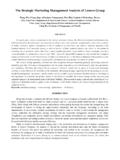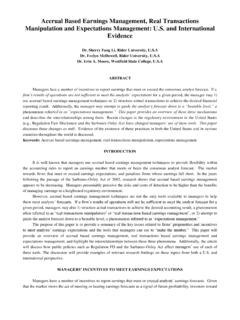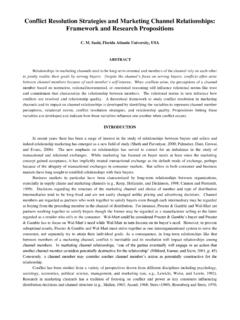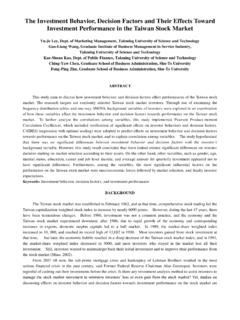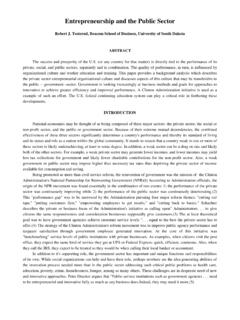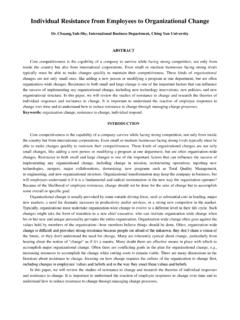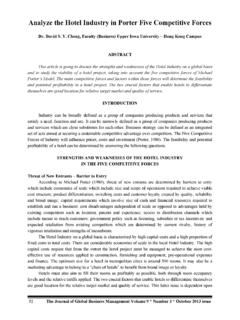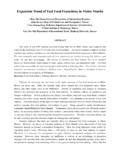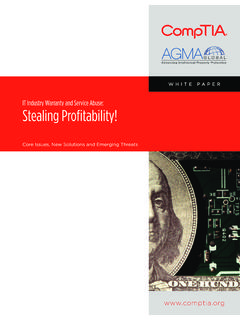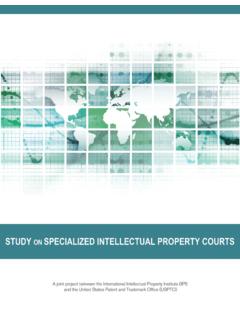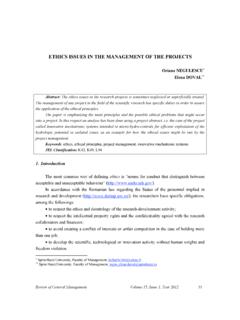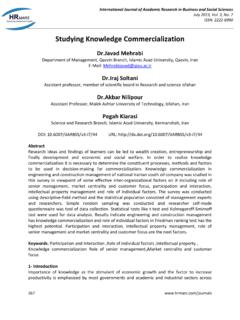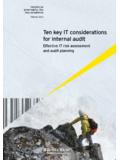Transcription of Legal Issues in Outsourcing: What Businesses …
1 Legal Issues in outsourcing : what Businesses should know Sion Kim, Rider University ABSTRACT Recently, the has seen a huge growth in offshore outsourcing relationships and experts agree that the first person to consult before negotiating an offshore outsourcing agreement, is a lawyer. However, because this outsourcing phenomenon is relatively new, business people cannot always rely on their lawyers to possess the degree of expertise necessary to grapple with all the Legal Issues involved. Consequently, Businesses should familiarize themselves with the main Legal Issues with respect to offshore outsourcing , in order to circumvent any unwanted developments later on. This paper will present a high-level overview of offshore outsourcing , and its Legal considerations. INTRODUCTION Recently, the has seen a huge growth in offshore outsourcing relationships and experts agree that the first person to consult before negotiating an offshore outsourcing agreement, is a lawyer.
2 However, because this outsourcing phenomenon is relatively new, business people cannot always rely on their lawyers to possess the degree of expertise necessary to grapple with all the Legal Issues involved. Consequently, Businesses should familiarize themselves with the main Legal Issues with respect to offshore outsourcing in order to circumvent any disastrous developments later on. This paper will present a high-level overview of offshore outsourcing , and its Legal considerations. By way of introduction, outsourcing can be defined as the strategic use of 3rd parties to perform tasks previously handled internally. outsourcing can provide many benefits. Among these are (1) lowering of costs for the outsourcing party, (2) compensation for lack of internal expertise, (3) freeing of managerial and governing personnel to focus on their core competencies and high level Issues , and (4) availability of best-in-class practices and the latest technology.
3 outsourcing has its drawbacks as well. Among these are (1) decrease of in-house expertise; (2) partial or total reliance on a 3rd party, (3) reduction in staff morale, (4) unexpected differences in level of services provided (5) incurrence of higher costs when company is compelled to use its own time and resources to train the provider, (6) incurrence of higher costs due to the provider s compliance with local laws, (y) unexpected difficulties due to cultural differences. The types of services that can be outsourced are diverse. In theory, any task that was previously handled internally can be outsourced. As a factual matter, the services that are most popularly outsourced are the following: (1) inventory control; (2) research and development services, (3) data processing services, (4) transcription services, (5) customer call centers, (6) technology services, (7) software development, and (8) business processes.
4 Steps in the outsourcing Relationship The first step an any outsourcing arrangement, is to identify the requirements of the company. The second step is to draft and distribute its Request for Proposals ( RFP ). Again, the vendor should set forth its requirements with clarity, and if possible, in measurable terms. Many times, the vendor may want to include in its RFP, the minimum service levels that it requires, again if possible, in measurable terms. The third step for the customer, is to review the proposals that it receives and evaluate the various vendors. Certain points that should be kept in mind when choosing the vendor, are the following: (1) Is the vendor financially stable?; (2) Does the vendor have a proven track record? (If possible, the customer should try to obtain references from former customers); (3) Does the vendor have the needed skill sets to fulfill the requirements or will they be training themselves on the customers time and budget, (4) Is the vendor located in a outsourcing friendly locale or does it have to comply with onerous civil regulations and import controls?
5 ; and lastly, (5) what Legal liabilities might the customer be exposed to when sending business to the vendor s locale? After the vendor is chosen, negotiations will be held and an agreement will be drafted between the customer and vendor. Terms of outsourcing Agreement The next major task for parties entering into the outsourcing arrangement, is to negotiate and set forth, the terms of the outsourcing agreement ( Agreement ). The Agreement is the crux of the outsourcing arrangement as it will be the guiding document by which the vendor and customer pursue their respective obligations. The various terms of the Agree that will be negotiated are the following: (1) The Term of the Agreement; (2) The Services to be Provided (scope of the agreement) (3) Ownership of Intellectual Property ( IP ); (4) Ownership and Confidentiality of Data and Trade Secrets; (5) Delegation of responsibilities; (6) Warranties and Indemnities; (7) Disclaimers; (8) Force Majeure; (9) The Choice of Law and Jurisdiction; (10) The Termination Clause.
6 Term of Agreement With regard to the Term of Agreement, the customer should negotiate for a short period with renewal options, giving it greater flexibility in continuing with or terminating the outsourcing relationship. A nationwide survey found that the typical term was 5-10 years. Services to be Provided With regard to the Services to be Provided, it is vital that the customer set forth its expectations as specifically as possible. It is crucial that measures for performance are clear and accurate due to the fact that without them, there are no objective criteria for managing the outsourcing relationship. The agreement should define measurable goals and benchmarks to determine the success or failure of the outsourcing . The customer may also want a Service Level Agreement to accompany the main contract.
7 The Service Level Agreement ( SLA ) can be viewed as a document that lays out the performance standards with as much detail and specificity as possible. The SLA will set forth the minimum service levels according to a quantifiable metric, and also set forth the penalties for failure to meet the minimum service levels. With respect to the SLA, the Issues that usually arise are when to measure service levels ( , hourly, daily, weekly, monthly) and who will conduct the measurements. The customer should also anticipate changes in the nature of services, (such as volume changes to the existing services, or the need for new services), and accordingly, make sure that the Agreement contains the necessary provisions to accommodate these changes. Warranties A Warranty is quite simply, an assurance.
8 Perhaps the single most important warranty that the customer should expect from the vendor, is the promise that the vendor can and will provide the services as defined in the contract, and that it will accommodate and increase in requirements or any new services that are needed. If the warranty is breached, the vendor will usually be responsible for all Legal liability incurred as a result of the breach and the customer may terminate the contract if he so wishes. An indemnity is essentially a promise to pick up the tab for problems caused by vendor s breach of the license agreement. Disclaimers Disclaimers are contractual provisions that limit liability. The most common disclaimer in an outsourcing relationship is usually the declaration that the vendor will not be liable for any indirect, special, or incidental damages arising out of the use of third party software or services, or arising from the inability of the Customer s to fulfill its obligations under the Agreement.
9 The Customer should accept that disclaimers will be part of the contract; nevertheless, the Customer should make sure that the disclaimers do not void the Warranty and Indemnity sections. Force Majeure Force Majeure literally means "greater force". Force Majeure clauses excuse a party from liability if some unforeseen event beyond the control of that party prevents it from performing its obligations under the contract. Typically, Force Majeure clauses cover natural disasters or other "Acts of God. This provision sets forth the various conditions whereby the vendor can be excused from performance. Such lapses in performance should be limited to a 30-60 day period. It is important to remember that Force Majeure clauses are intended to excuse a party only if the failure to perform could not be avoided by the exercise of due care by that party.
10 When negotiating Force Majeure clauses, make sure that clause sets forth some specific examples of acts that will excuse performance under the clause, such as wars, natural disasters, and other major events that are clearly outside a party's control. Inclusion of examples will help to make clear the parties' intent that such clauses are not intended to apply to excuse failures to perform for reasons within the control of the parties. Ownership Issues The determination of ownership for IP existing before the implementation of the outsourcing arrangement is crucial, particularly with regard to termination of the relationship. Without this pre-determination of ownership, the allocation of assets may be nearly impossible. The contract should specify which party owned which IP assets before the outsourcing was implemented.
